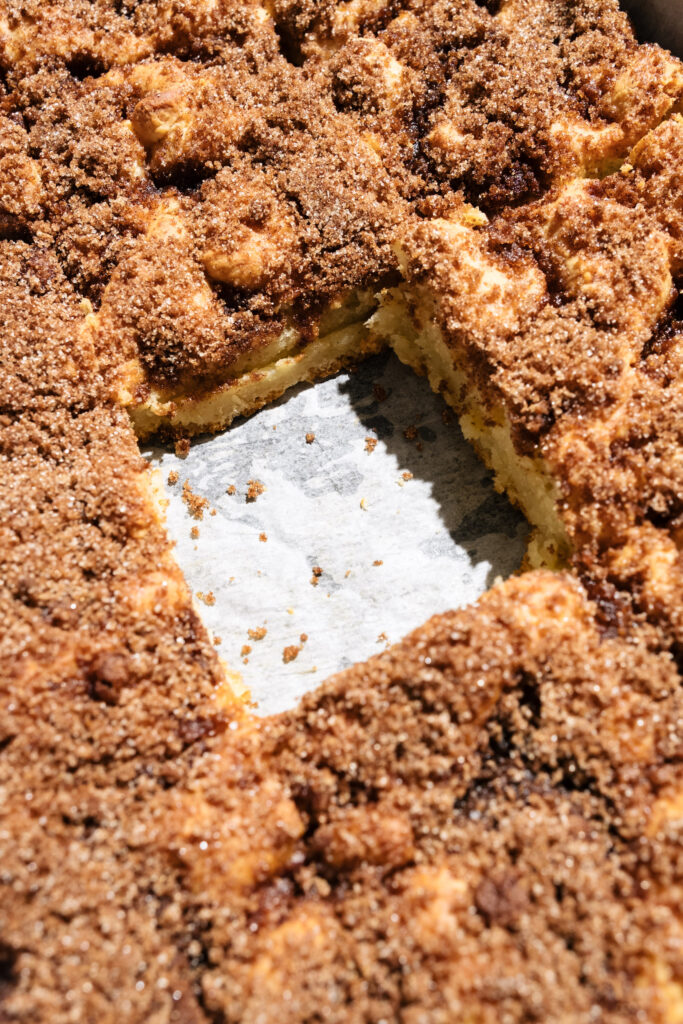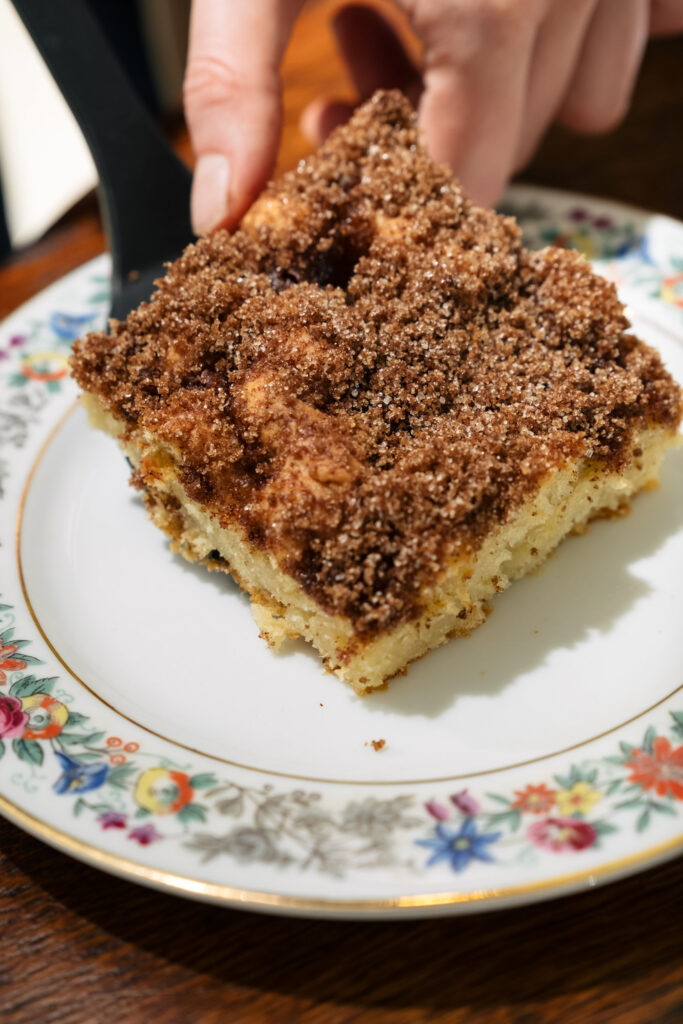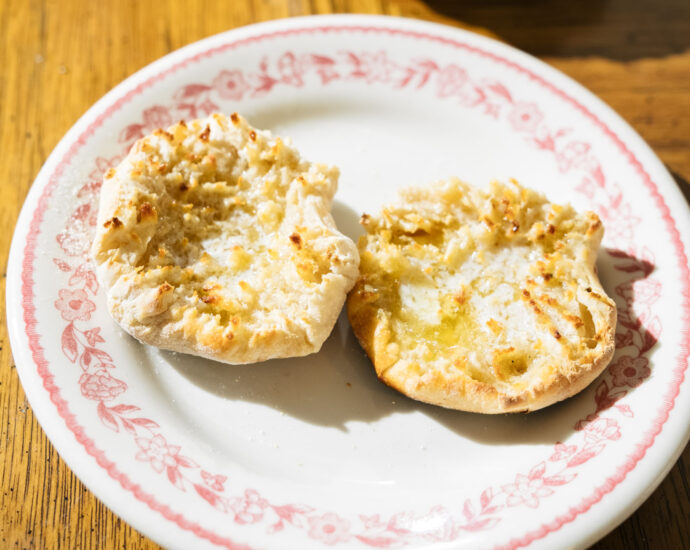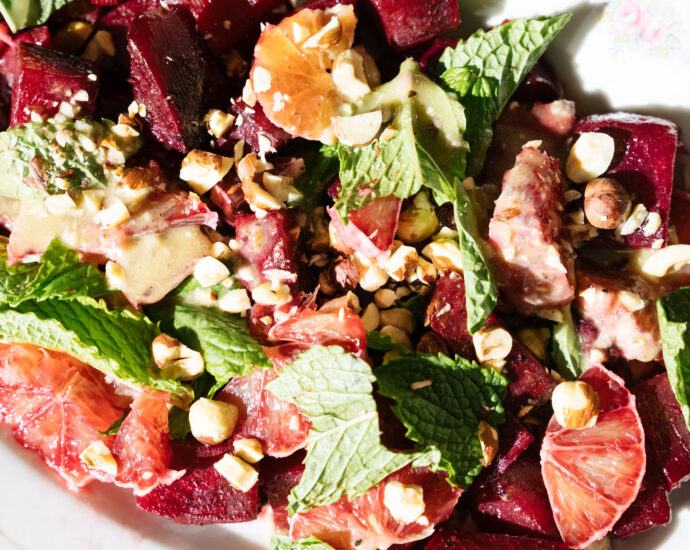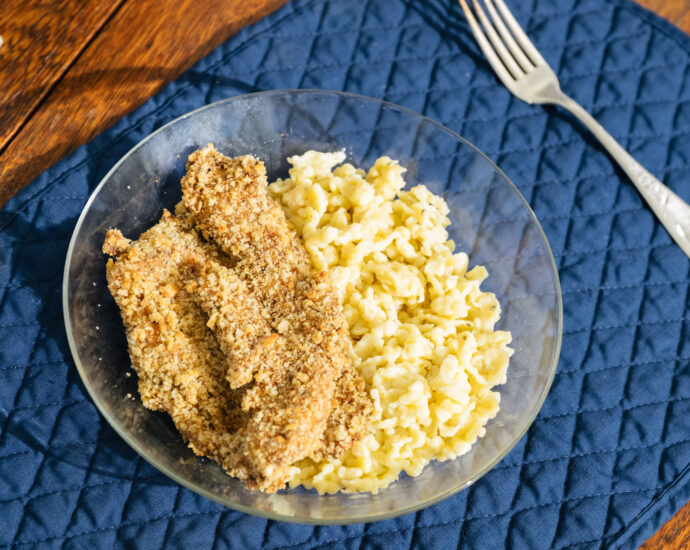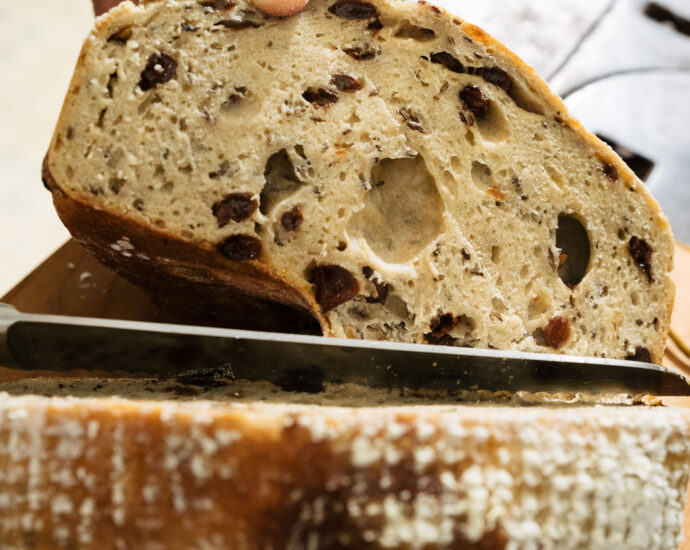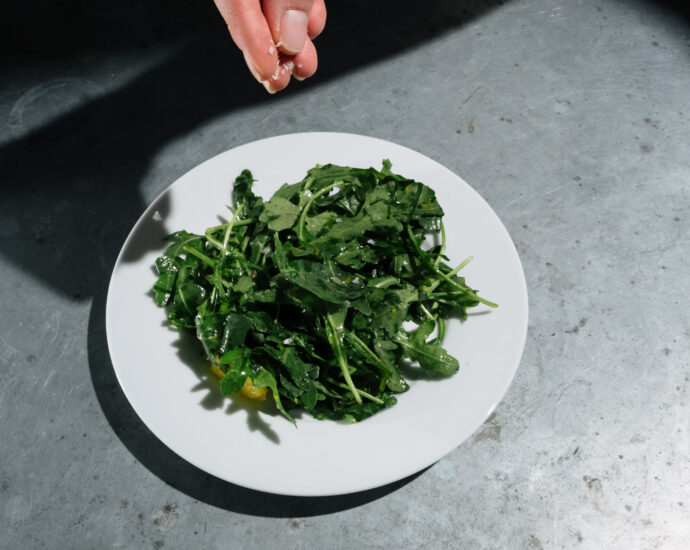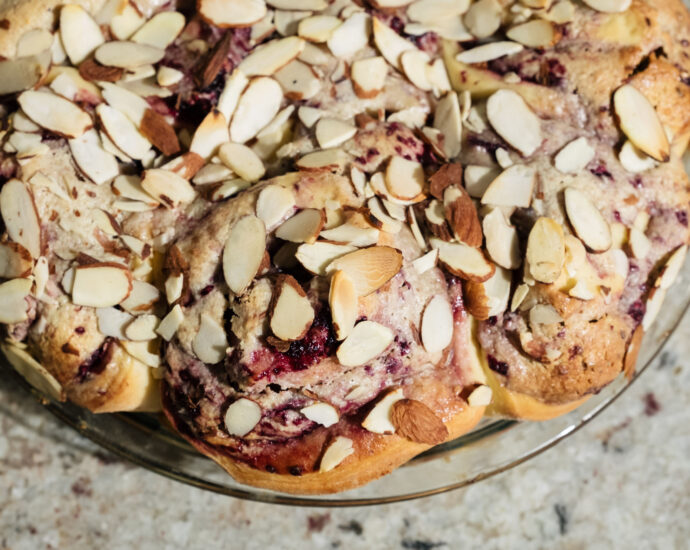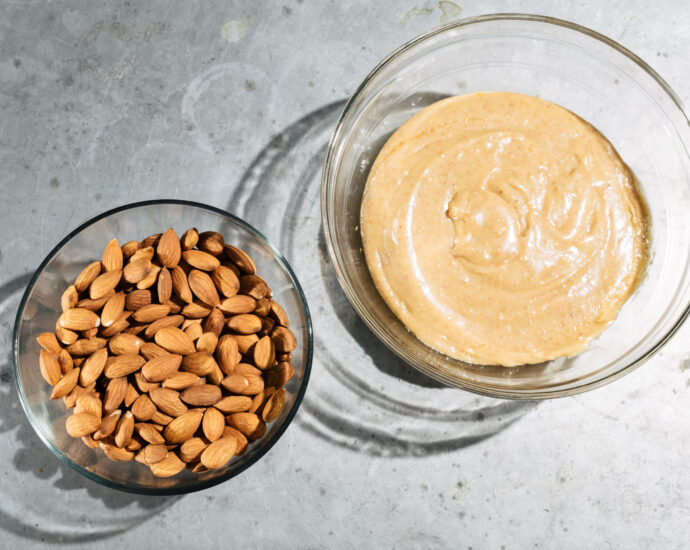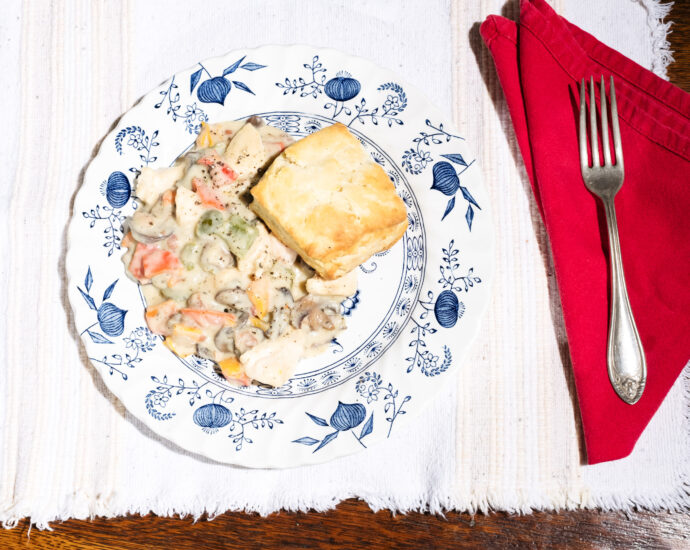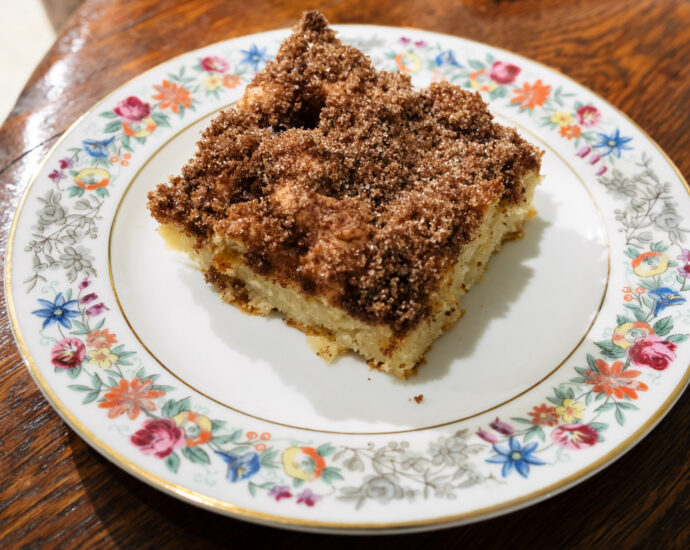sourdough english muffins
English muffins are an any-time-of-the-day kind of food. You can eat them first-thing in the morning, slathered with fresh butter or in the afternoon with smashed avocado. Use them to mop up runny eggs or top them with chicken, vegetables, and cheese for an open-faced sandwich. English muffins, especially sourdough english muffins, also make a great base for party snacks!
I grew up on Thomas’ English Muffins – regular, whole wheat, honey wheat, etc., and I still have a soft spot for their “nooks and crannies”. I remember my dad carefully instructing my sister and me to use a fork – never a knife – to split the muffins in two, giving us maximal jagged surface area for spreading whipped butter and cherry preserves.
These sourdough english muffins are easy + inexpensive to make and are thoroughly layered with flavor and texture. I opt to toast before eating, but they are just as delicious warm from the pan.
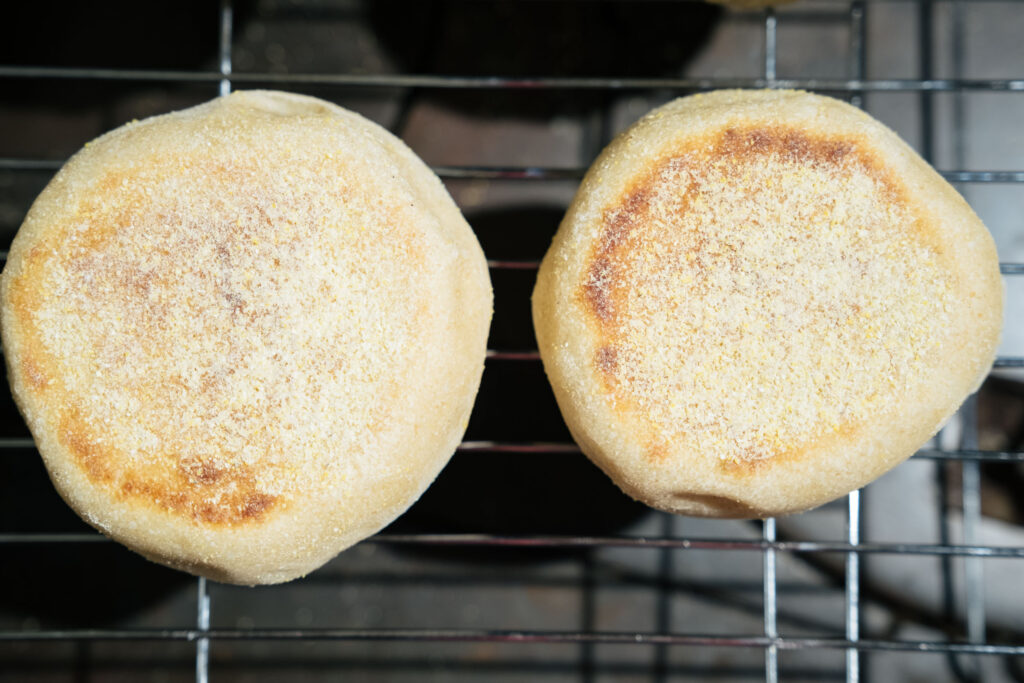
ingredients
- ½ cup (100 grams) sourdough starter
- 1 tablespoon (20 grams) honey
- 1 tablespoon (20 grams) sugar
- 1 cup (240 grams) milk
- 3 cups (380 grams) all purpose flour
- ½ teaspoon (5 grams) kosher salt
- ¼ cup (40 grams) cornmeal for dipping and coating dough
steps
12-14 hours before baking (the night before)
Add the sourdough starter, honey, sugar, milk, flour, and salt to a bowl and mix evenly. Let sit for 30 minutes.
Knead for 5 minutes. I like to use a stand mixer, but you can knead by hand if you prefer. The dough will be sticky.
Let the dough sit at room temperature for 12-14 hour overnight.
morning of baking
Divide the dough evenly into 10 pieces. Shape each piece into a round by repeatedly turning it under itself and pinching it together on the bottom.
Place cornmeal in a shallow bowl and roll the top of each muffin in the cornmeal, cover with plastic wrap, and let rise at room temperature for an hour.
Preheat a non-stick skillet over medium-low heat. Place muffins into the skillet, 3-4 at a time. Cook for 5 minutes with the cornmeal side down, flip, and then cook for another 5 minutes.
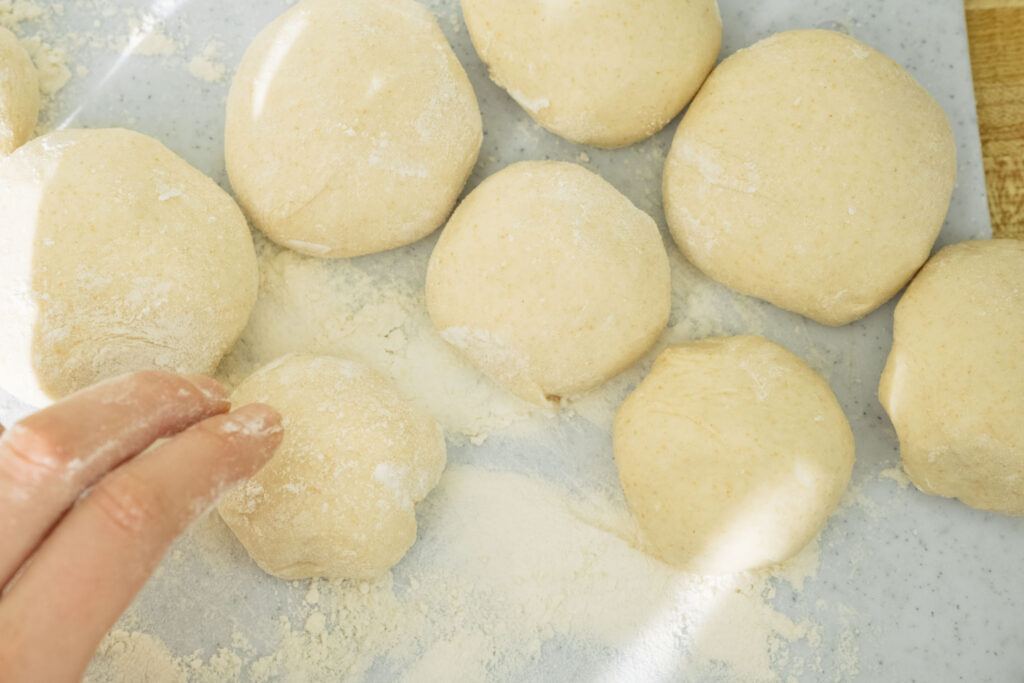
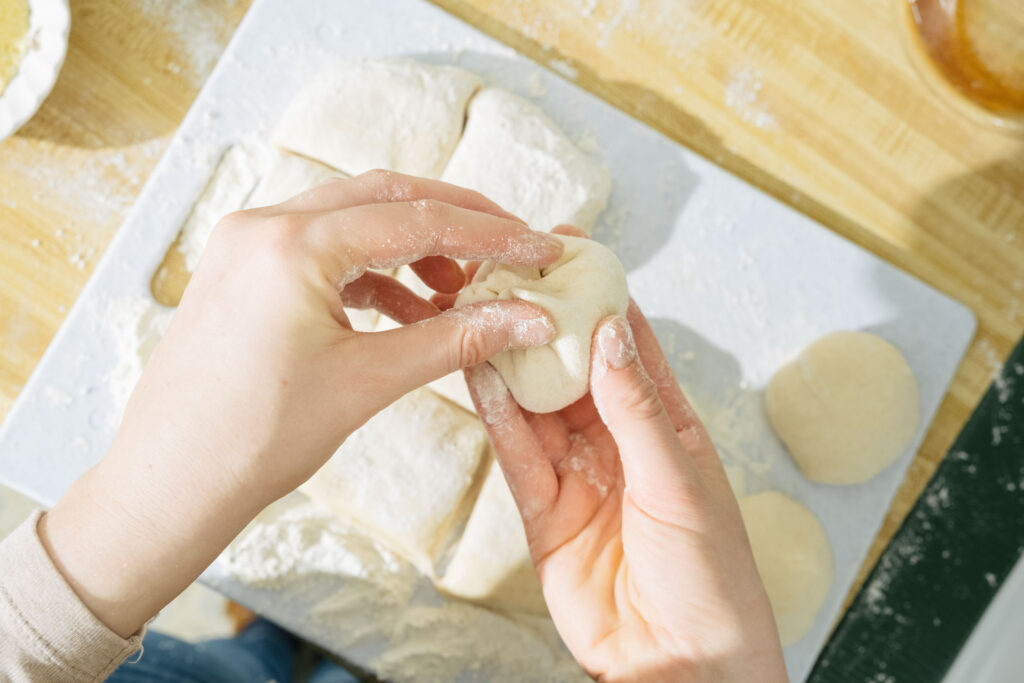
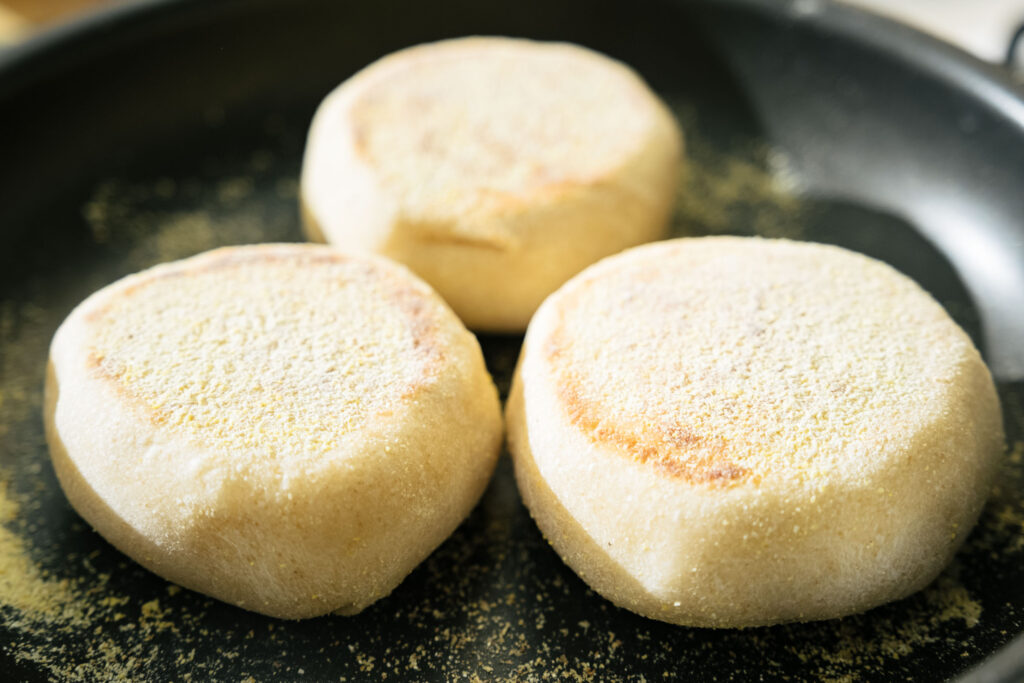
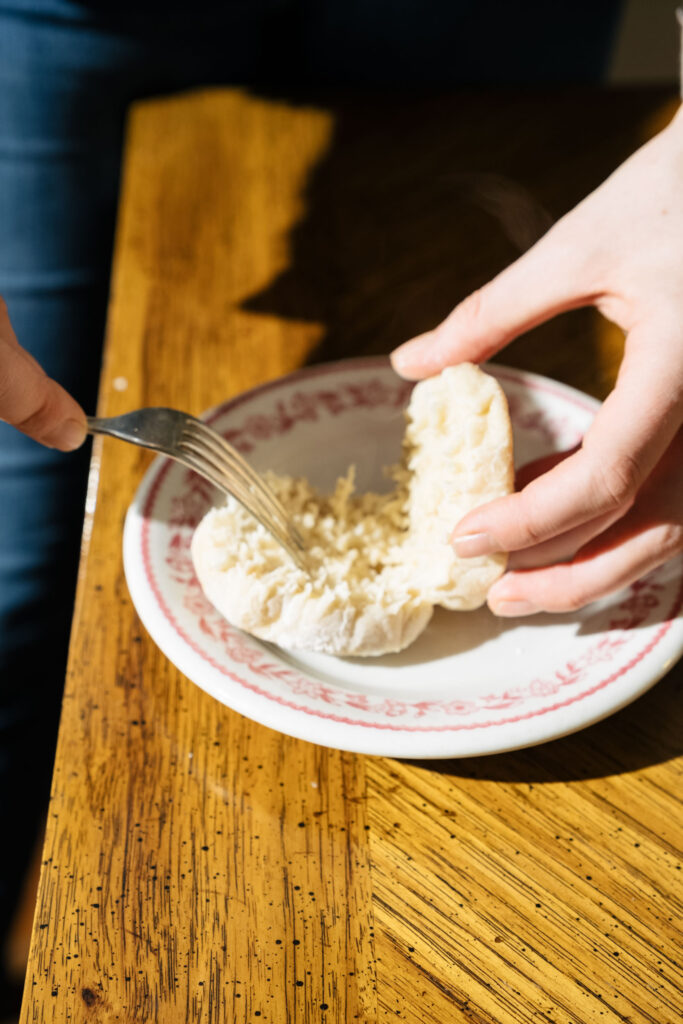
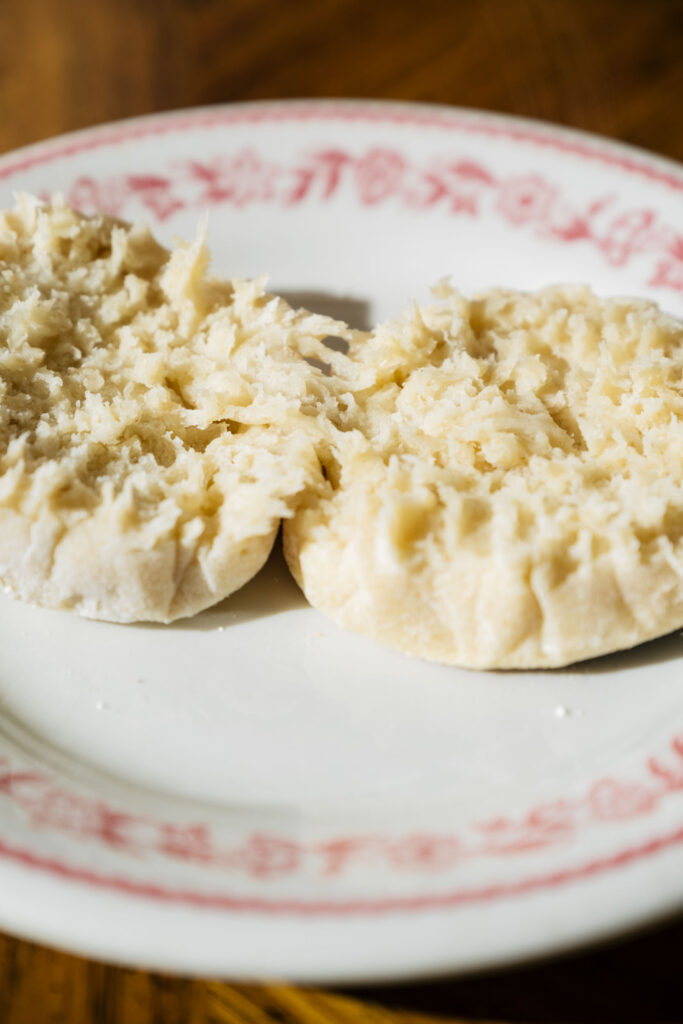
roasted beets with blood orange, mint, hazelnuts, and lemon anchovy vinaigrette
I love beets. I love them boiled, roasted, pickled, in soup. I love their brilliant burgundy color. I love their subtle sweet flavor. I love their versatility. I love their countless health benefits. I want everyone to love roasted beets as much as I do.
Give these roasted beets a try if you are beet-curious or even beet-averse. Not only do the flavors blend harmoniously together but the colors are so beautiful and vibrant that you can’t help but marvel at the shades of red, pink, orange, maroon.
This dish really accentuates all the wonders roasted beets have to offer, enhanced by blood orange in celebration of citrus season, crisp mint, earthy hazelnuts, and the salty tartness of lemon anchovy dijon. Who could resist?
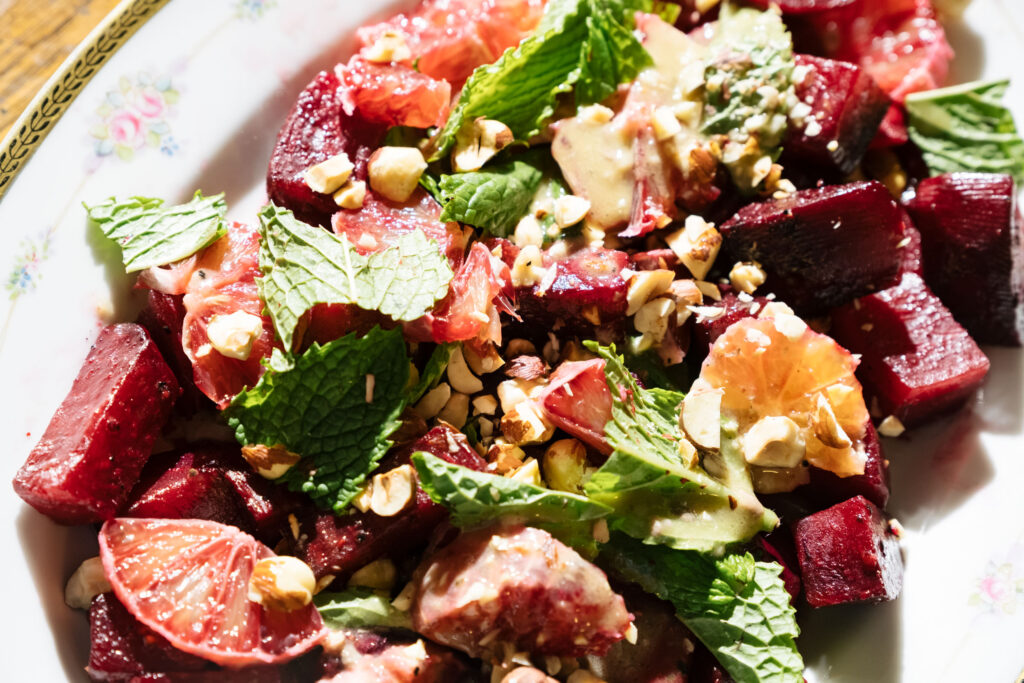
Serves 4
ingredients
for the salad
- 1 bunch beets, with greens reserved (use the greens at a later time)
- 2 tablespoons olive oil
- 1 tablespoon kosher salt
- 1 teaspoon freshly ground pepper
- 1 blood orange, peeled and sliced
- ½ cup loosely packed mint leaves, torn
- ¼ cup hazelnuts
for the vinaigrette
- 2 tablespoons of lemon juice (from about 1 lemon)
- 5 anchovies, chopped
- 1 teaspoon dijon mustard
- 1 teaspoon red or white wine vinegar
- ½ cup olive oil
steps
Preheat the oven to 425°F. Peel and chop the beets into 1-inch-sized pieces. Place the beets on a large piece of foil on a sheet pan. Drizzle with 2 tablespoons olive oil, 1 tablespoon kosher salt, and 1 teaspoon freshly ground pepper. Fold up beets so that they are completely wrapped up in the tin foil. Bake for 45 minutes.
Place hazelnuts on a separate baking sheet and toast for 10 minutes then remove from the oven, let cool, and chop.
Meanwhile, add the chopped anchovies to a bowl and mix in the lemon juice, dijon, and vinegar. Whisk to break down the anchovies. Slowly drizzle in the olive oil in a steady stream while whisking until the dressing has emulsified. Set aside.
Remove the beets from the oven and let cool slightly then transfer to a dish. Scatter with the blood orange slices and mint leaves. Pour the dressing over the dish and top with the toasted hazelnuts.
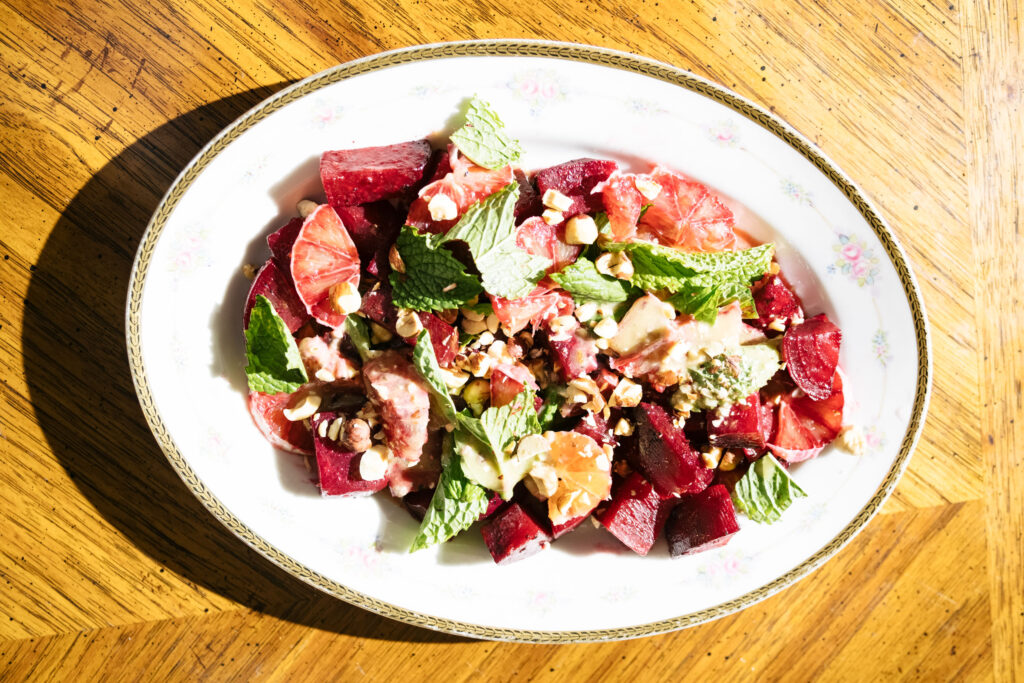
pastrami chicken schnitzel
Breaded chicken, also known as “schnitzel” in German, is a real culinary delight. I am sure you have heard of wiener schnitzel, which is quite popular in Austria, one of the countries my family descends from. And who can forget the timeless song “My Favorite Things” in which Julie Andrews sings “schnitzel with noodles”. Thus, pastrami chicken schnitzel is a new take on an old classic.
Schnitzel meat is typically pounded to a thin slice, dredged in flour, dipped in egg, and covered with a fine layer of breadcrumbs, then fried up to crisp perfection.
For this pastrami chicken schnitzel, I have omitted the flour and opted to bake the schnitzel instead of frying it for a lighter, less laborious process. In place of the flour is a pastrami spice blend that has been finding its way into our cooking quite often. We use the smoker to make hot smoked salmon, all kinds of jerky, and meat — so we decided to create a pastrami spice mix to compliment it.
The best part of this pastrami chicken schnitzel recipe is that you will have leftovers of the pastrami spice mix after making this recipe, which you can use for other meat, potatoes, veggies, fish!
Note: The proportions on this spice blend are suggestions — feel free to add or subtract to your liking — but this is the essence of a pastrami seasoning.
serves 4
ingredients
for the pastrami spice mix
- 2 tablespoons coriander seed
- 1 heaping teaspoon juniper berries
- 2 teaspoons caraway seed
- 2 teaspoons black peppercorns
- 1 teaspoon Spanish style smoked paprika
- 1 pinch of Aleppo pepper
- 1 teaspoon mustard powder
- 2 teaspoons salt
- 1 tablespoon brown sugar
for the chicken
- 2 8-ounce boneless skinless chicken breasts
- 1 egg, beaten
- 2 cups breadcrumbs
In a saucepan, toast coriander, juniper berries, caraway seed, and black peppercorns individually, each for 3 minutes. Add to spice grinder and grinder until powdered. Add to a bowl and mix in the smoked paprika, aleppo pepper, mustard powder, salt, and brown sugar. Set aside.
Butterfly chicken breasts by running your knife alongside the middle and splitting in half. You will have 4 pieces.
Place one piece into a plastic freezer bag and pound it with a mallet or a rolling pin until it is about ⅛ inch thick. Repeat with 3 remaining pieces.
Generously season the chicken with pastrami mix and and let sit for 10 minutes.
Place the egg in a small shallow bowl. Place the breadcrumbs in a second small shallow bowl.
Preheat the oven to 350°F. Line a sheet pan with parchment paper.
Dip one piece of chicken in the egg then immediately in the breadcrumbs. Place on the sheet pan. Repeat with remaining chicken. Cook for 10 minutes then flip schnitzel on pan and cook for another 10 minutes on the other side. Schnitzel is finishing when it begins to turn golden brown. It will cook fairly quickly since the pieces are so thin.
Serve with noodles!
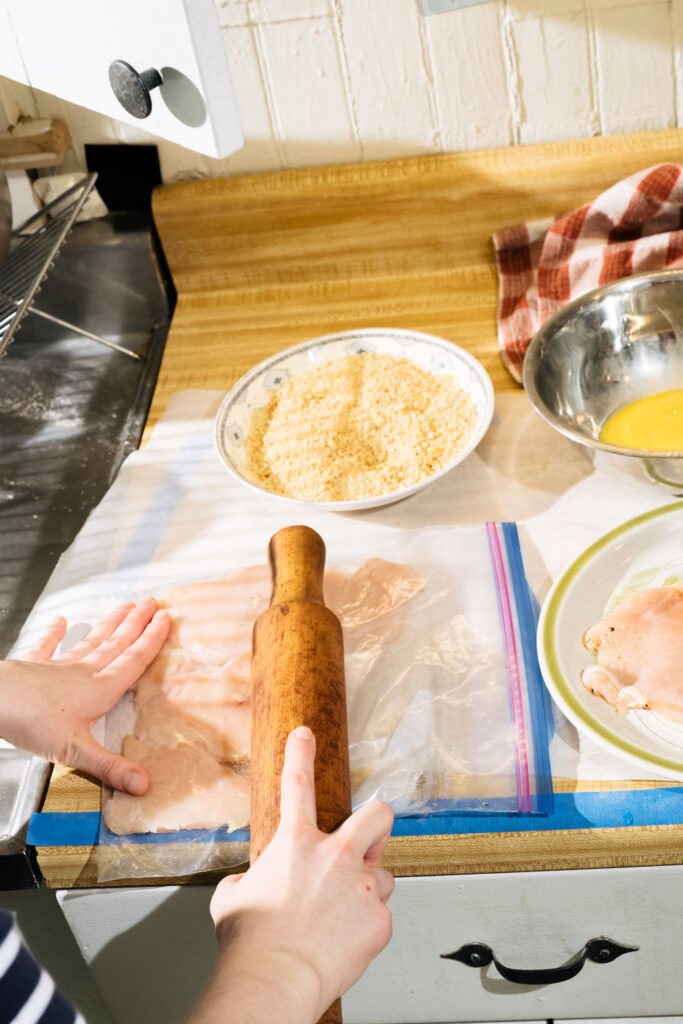
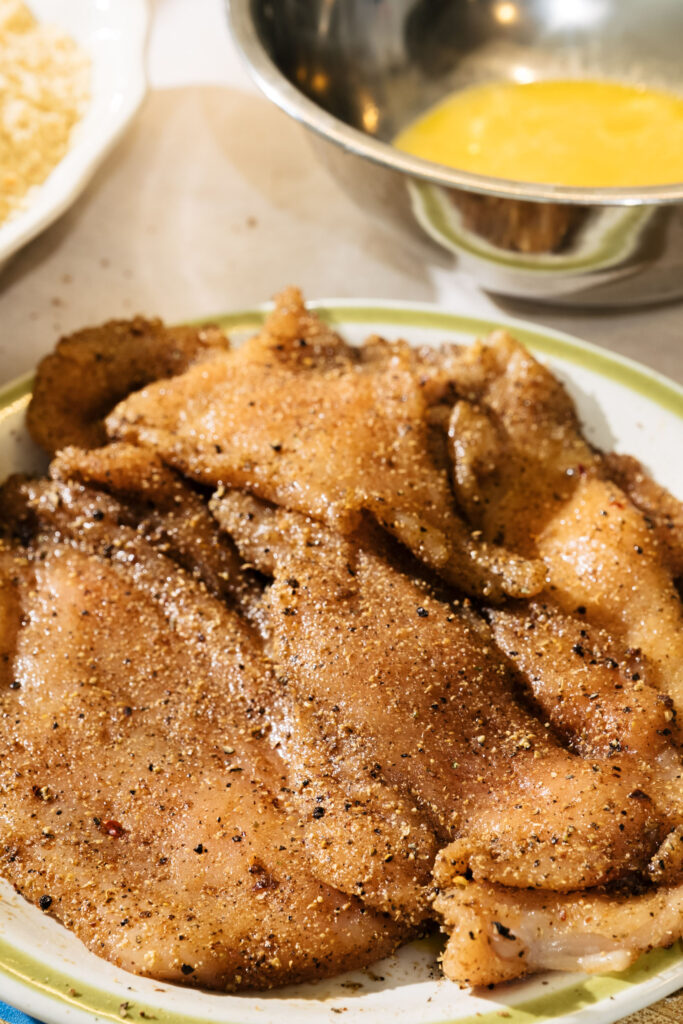
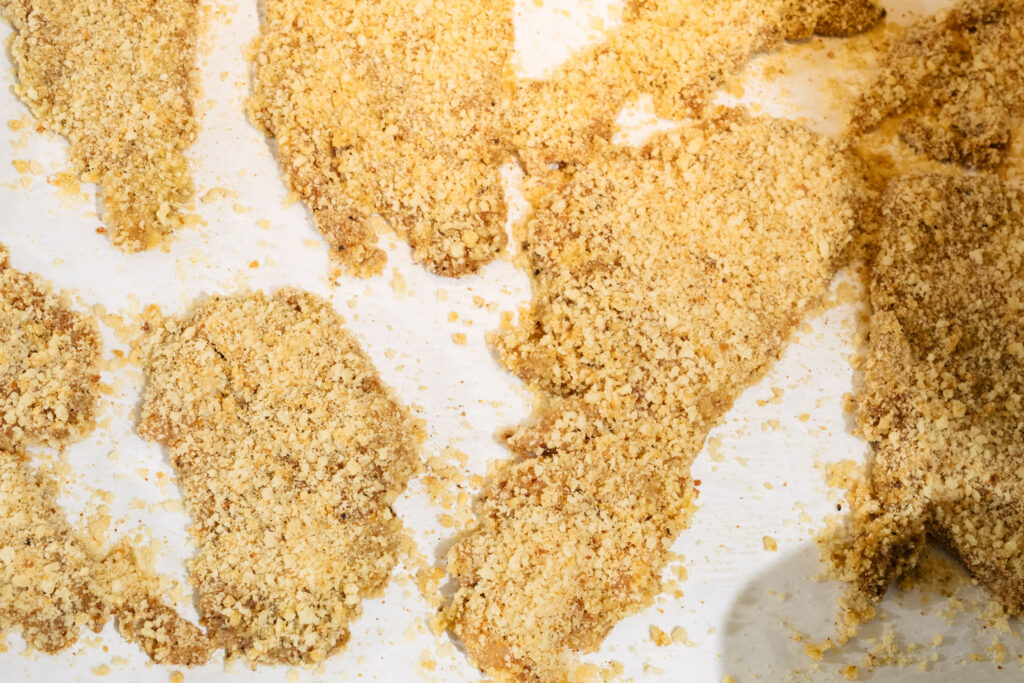
raisin caraway sourdough
This recipe for raisin caraway sourdough comes at the request of my boyfriend who loves both caraway seeds and raisins. I grew up eating seeded rye bread from the local German bakery, so for me, caraway seeds are always fragrant and nostalgic.
The flavors in these loaves are like that of Irish soda bread but with the chewy and crusty texture and tang of sourdough. I find this raisin caraway sourdough to be quite satisfying, and it may just inspire a whole new world of flavor possibilities for you, too!
I recommend using a dough scraper to help you work with and transfer your dough. It also helps scrape the sides of the bowl in its initial stages when it is still quite wet.
When adding mix-ins to sourdough bread, the key steps are to:
- Soak the fruit and the seeds in water and add them along with most of their water to the dough
- Add the mix-ins at the beginning of the first fold and gently massage them into the dough
makes 2 loaves of bread
ingredients
for the levain
- 1 tablespoon mature sourdough starter
- ¼ cup whole wheat flour
- ¼ cup all-purpose flour
- ⅓ cup water
for the dough
- 2 + ¼ cups water
- 5 cups all-purpose or bread flour
- ½ cup whole-wheat flour
- 1 tablespoon kosher salt
- 1 cup raisins, soaked in ½ cup of water
- 2-3 tablespoons caraway seeds, soaked
levain steps
The night before you plan to bake your bread, mix the levain by adding sourdough starter, ¼ cup whole-wheat flour, ¼ cup all-purpose flour, and ⅓ cup water in a bowl. Cover with plastic wrap and a towel and let sit for 12 hours.
Your levain is ready when it is dotted with many small bubbles on top. To test that it is ready, drop it in water and see if it floats.
bread steps
Pour two cups of water into the levain and mix until it evenly dissolves. Add the flour and mix into a shaggy dough. Cover with plastic wrap and let sit for 30 minutes to 2 hours. This is the autolyse stage when the flour absorbs the levain. It is during this process that the dough becomes more elastic and begins to develop its depth of flavor.
Meanwhile, fill a small bowl or measuring cup with ¼ cup of water and 1 tablespoon kosher salt. Mix until the salt dissolves.
Once the dough has sat for at least 30 minutes, pour the salt water over the dough and begin to squeeze and pinch it into the parts of the dough. It will feel slimy and sticky and wet. It is at this point when you add in the raisins and caraway seeds and continue pinching and squeezing into the dough.
Begin to stretch the dough by pulling one end upwards and folding it in half over itself (see below photos). Turn the bowl 90° and fold the dough up and over itself once again. Do this 4 times so that in total, you have turned the bowl a full 360°! This is the first fold (of 6 total!)
Let the dough sit for 30 minutes then repeat the folding process 5 more times, every 30 minutes, for 2 and a half hours, each time turning the bowl four times and folding it up and over itself. As the dough rests it will absorb some of the moisture and become more ecstatic. You will notice that it becomes less sticky and easier to work with.
After you have completed all of the turns, remove the dough from the bowl and place it on a floured surface. Cut it in half and shape each half by pushing the sides underneath it to form a ball. Let sit.
Line two large bowls with a dish towel and generously coat with flour. (This is where a proofing basket comes in if you have one). Starting with the right side of one loaf, fold four corners to the center and place, fold-side up, into one of the bowls. Repeat with the other loaf. Let sit for ~3 hours at room temperature.
When ready to bake, preheat the oven to 500°F. Place two dutch ovens or heavy-bottomed pots 4 quarts or larger, with the lids on, inside for about 15 minutes. Remove from the oven and turn one loaf of dough into the pot with the side that was touching the towel or basket facing up. Repeat with the second loaf. If you only have one pot, you can bake the two loaves in a row.
Lower the oven to 450°F and bake for 25 minutes. Remove the lid and bake for another 10 minutes or until the crust is golden brown.
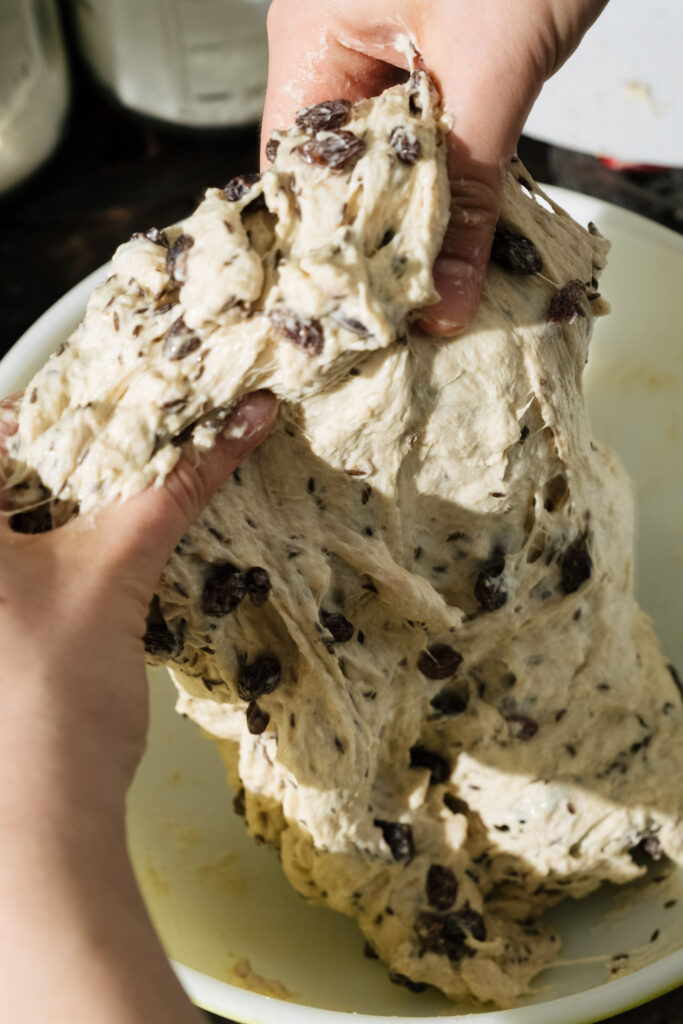
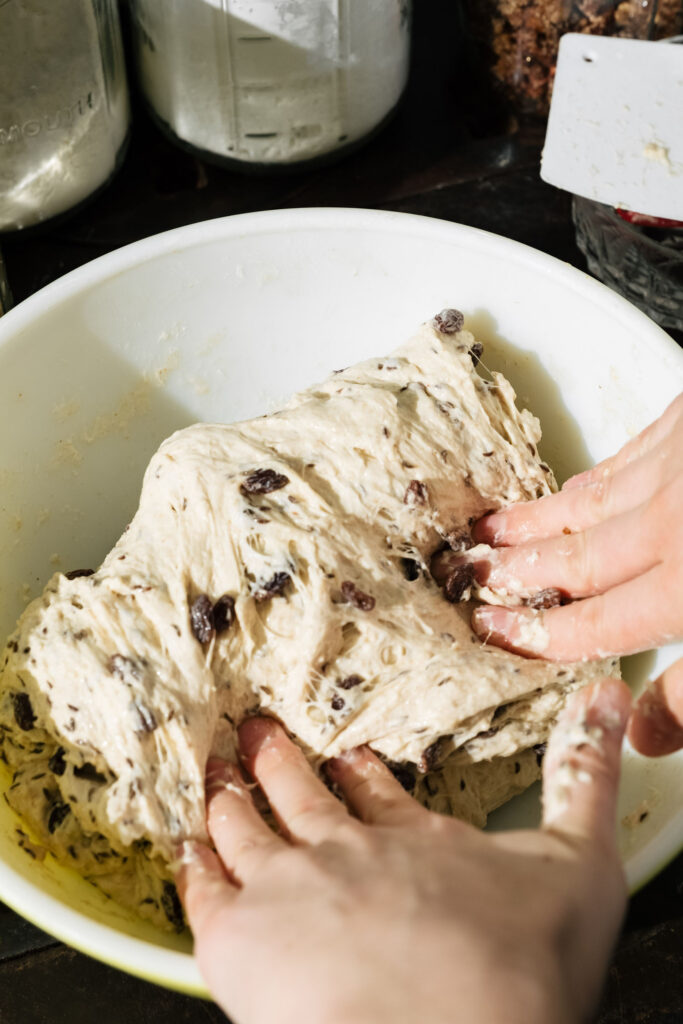
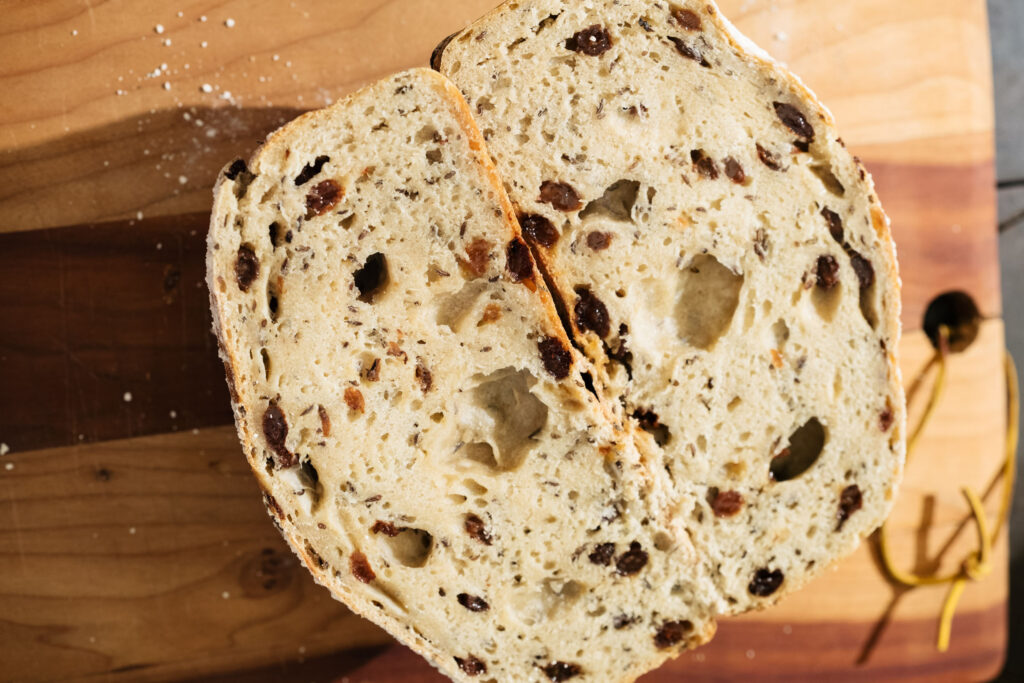
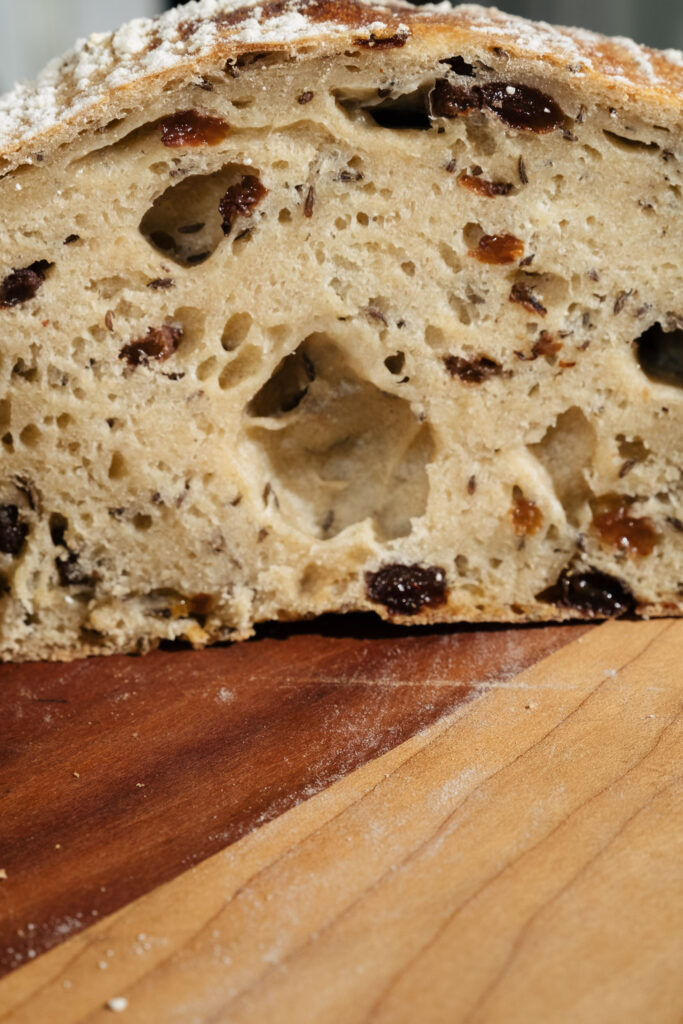
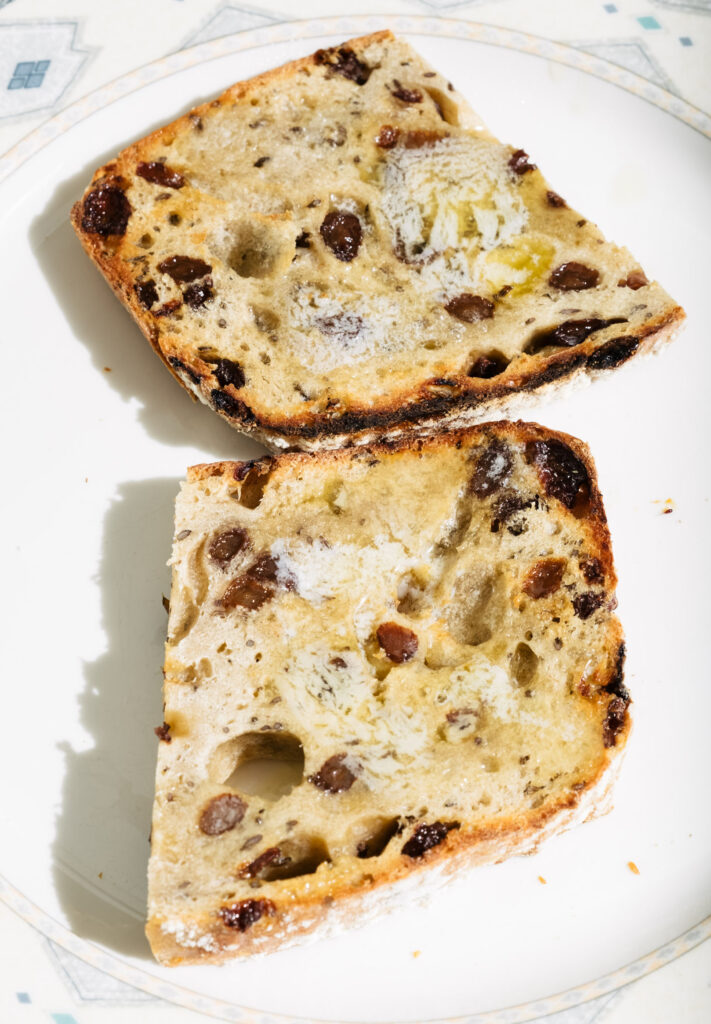
the easiest orange vinaigrette
Happy new year!!! I’ve said it before and I’ll say it again, I am always trying to fit more vegetables into my diet. And having the makings of a flavorful, healthy salad on hand is one of the simplest ways to do this. For me, a great salad starts with a straightforward dressing. Here is the easiest orange vinaigrette that I turn to time and again.
I like to make a big batch of this vinaigrette and use it over a few days on a simple, crisp arugula salad. The zest, combined with the aromatics adds flavor to every bite. It can also be used as a yummy marinade for meat, fish, or vegetables. Keep this around for a quick-veggie fix any time you feel the need for green. Here’s to a lighter, brighter new year!
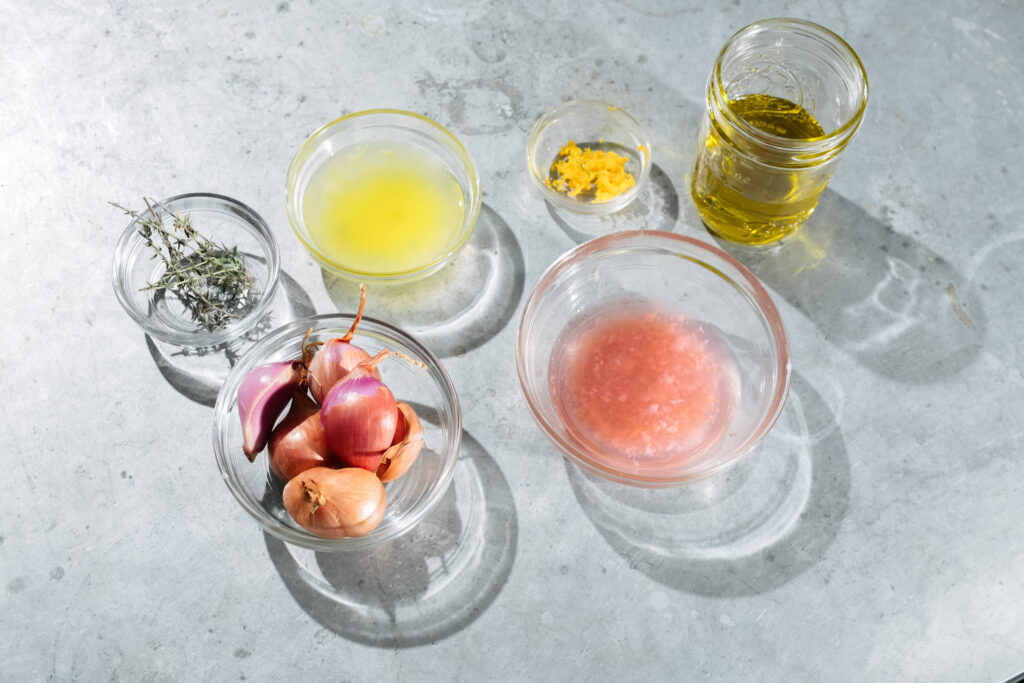
ingredients
- ¼ cup orange juice (from about 1 orange)
- 1 tablespoon orange zest
- 1 shallot, finely grated (I use a microplane to grate it extra finely)
- ½ teaspoon salt
- 3 sprigs of thyme leaves
- ¼ cup red wine vinegar
- ½ cup olive oil
steps
- Combine the orange juice, orange zest, grated shallot, thyme, and red wine vinegar in a bowl.
- Slowly whisk* the olive oil into the mixture, making sure to continuously keep mixing in order to emulsify.
- Season with salt and pepper and serve over your favorite greens or lettuce, I personally love arugula. Garnish with flaky salt.
*Alternatively, if you don’t have a whisk, you can add all ingredients to a mason jar and shake until the mixture is completely emulsified.
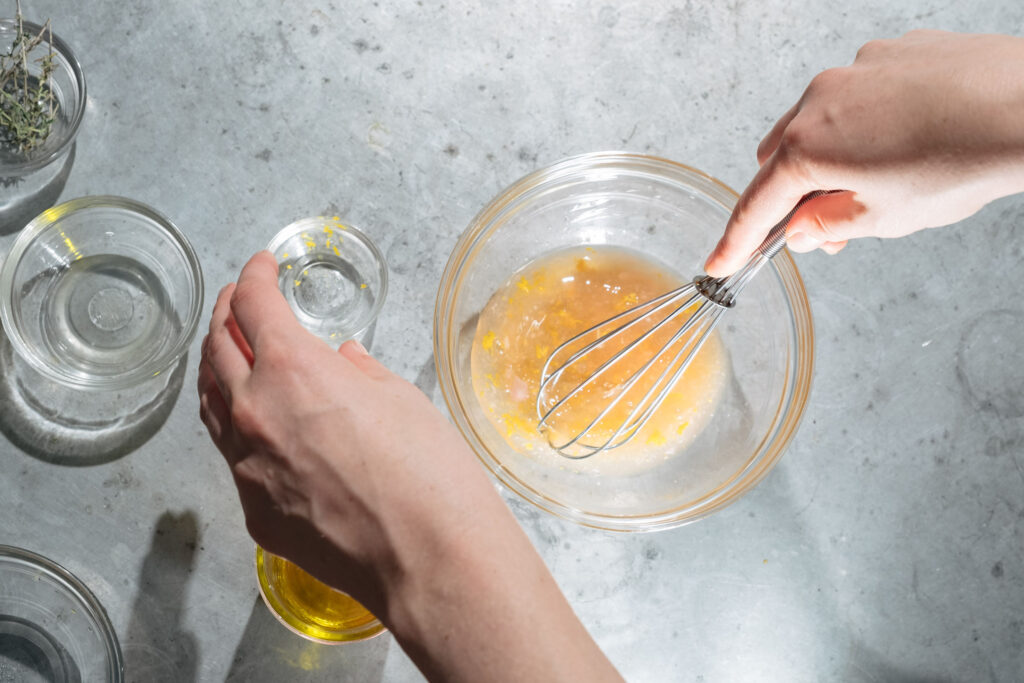
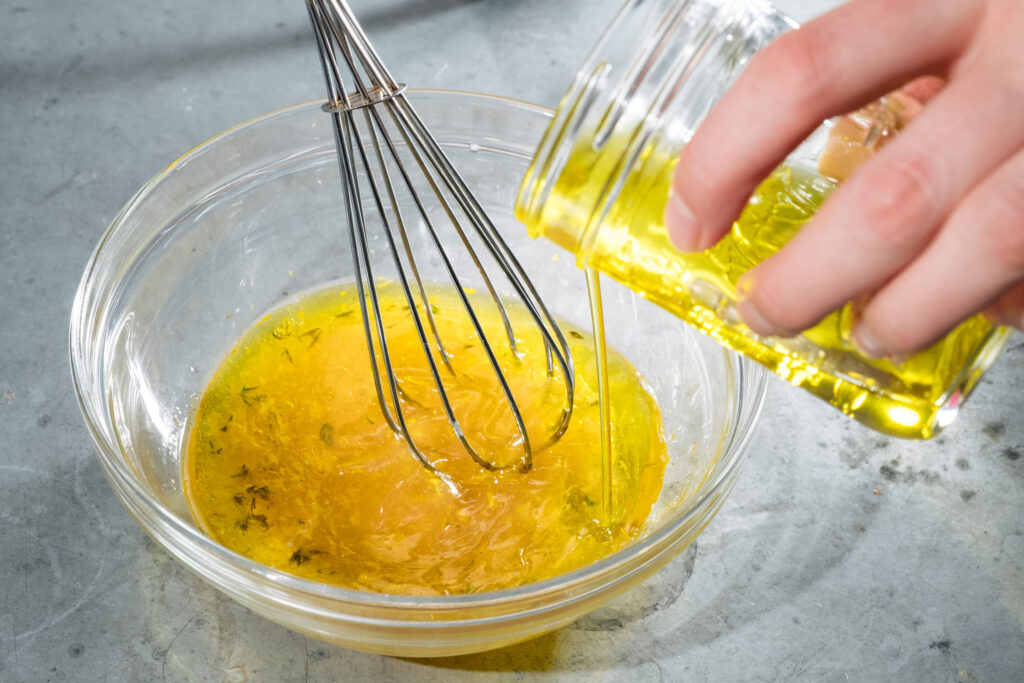
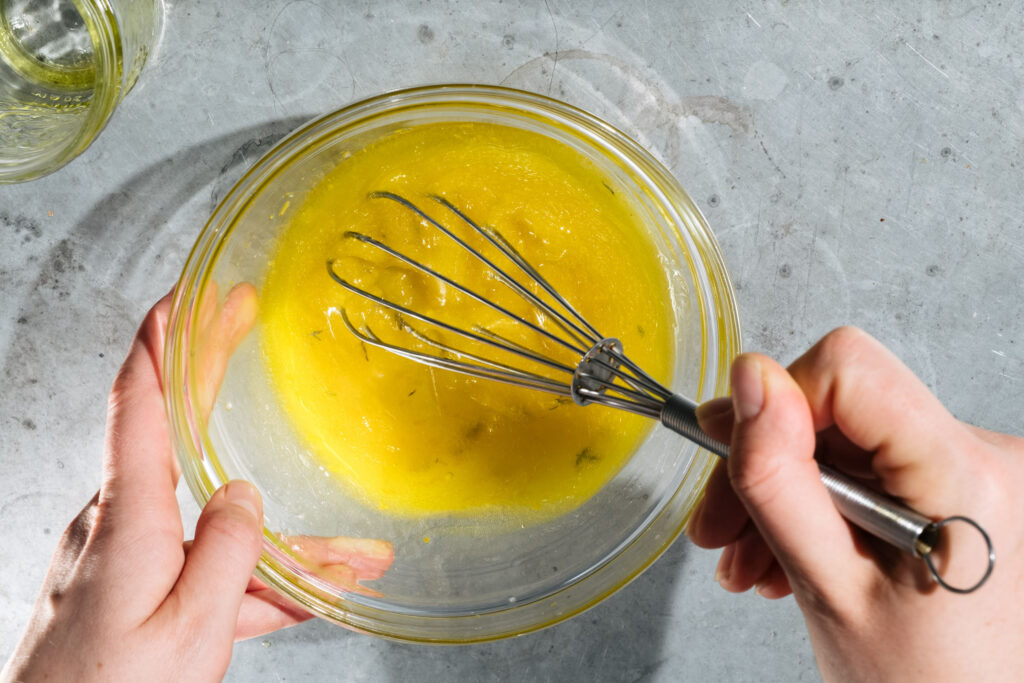
kir cidre royale
Kirs are colorful, fun, and festive in just about every way. The name Kir comes from Felix Kir who was a French priest and resistance fighter during the second world war. He allegedly loved to serve Kirs, which he made with crème de cassis and Aligoté, a dry white wine from the Burgundy region in France. Traditionally, a Kir Royale is made with champagne and a Cidre Royal is made with Dry Hard Cider and an apple Brandy like Calvados or Pommeau. Stir the two together and you’ve got a kir cidre royale !
The star ingredient of a kir cidre royale is a splash of crème de cassis — a blackcurrant liqueur, with a deep burgundy hue that mixes wonderfully with other bases. To me, these drinks are a dressed up version of the classic Shirley Temple.
So let’s toast to a brighter, healthier future for all and enjoy this kir cidre royal alongside some Crabbies or Pastrami Chicken Schnitzel as we await the new year. Happy 2021!
ingredients
- ½ ounce crème de cassis
- 2 ounces sparkling white wine
- 2 ounces dry hard cider
steps
In a glass, combine the crème de cassis, wine, and cider.


bostock buns
One of my favorite foods in the entire world are almond croissants. Part of what makes them so amazing is the frangipane — that rich, creamy, almond paste filling, layered with flavor. It is truly such a unique delight. Frangipane is also a main ingredient in bostock.
Bostock uses that very frangipane to elevate stale bread into a whole new league. It is traditionally days-old brioche bread that is coated with orange blossom syrup, slathered with frangipane, topped with slivered almonds, and baked to perfection. You can really use any bread as long as you have the foundation of a profound frangipane. Allow me to introduce: bostock buns.
My bostock buns are basically your classic cinnamon bun rolled up with frangipane and berry jam. The bostock beautifully blends with the jam, complementing the almond flavor. Enjoy this treat for breakfast and keep your entire day bright.
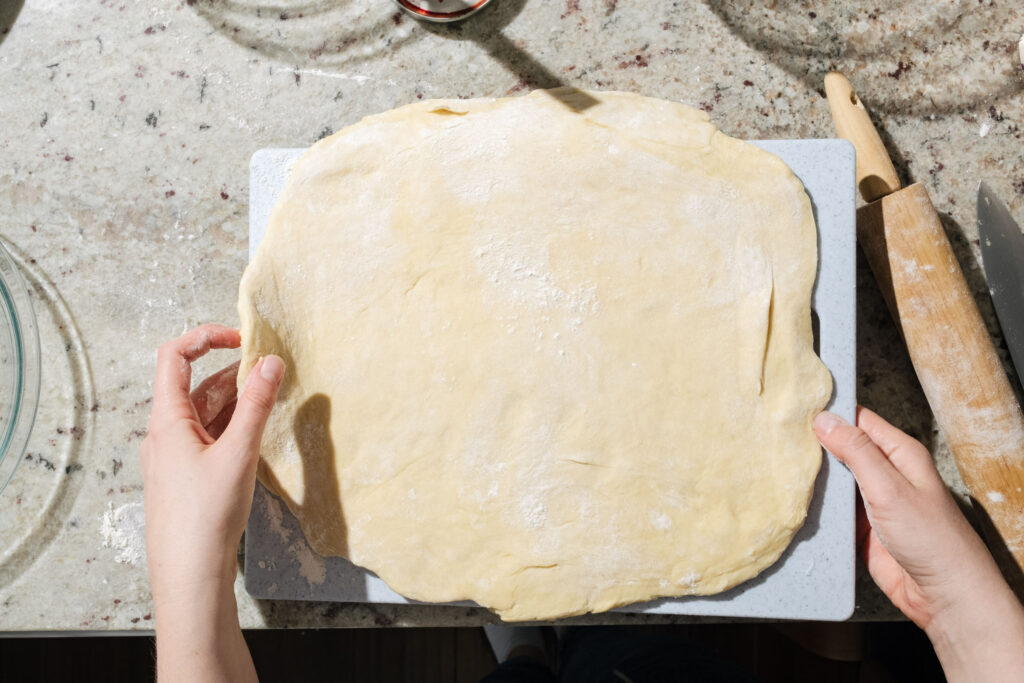
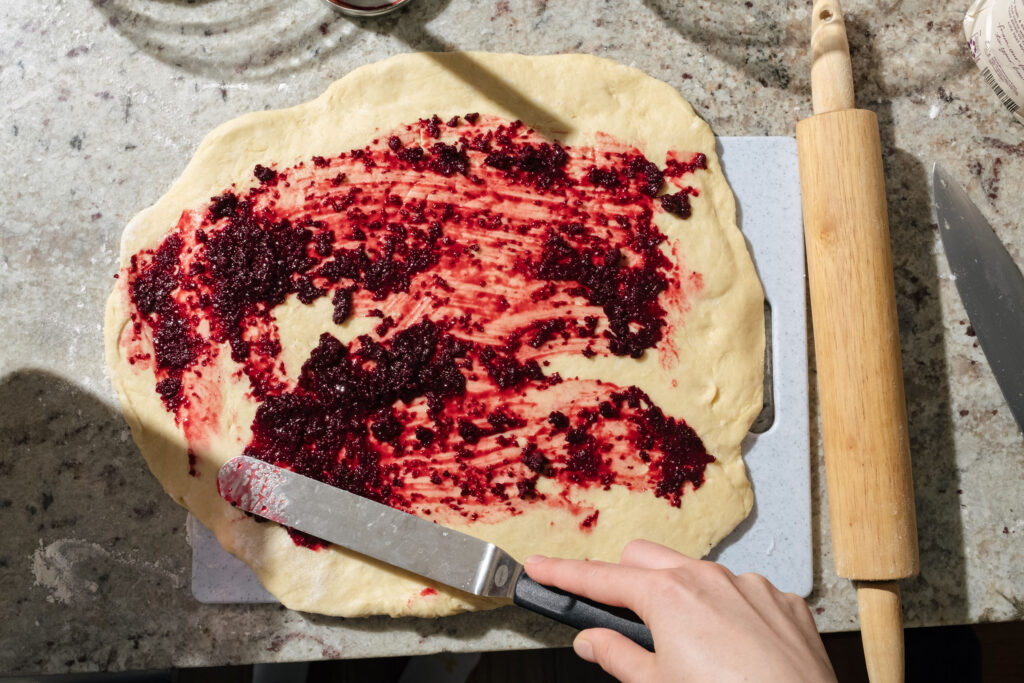
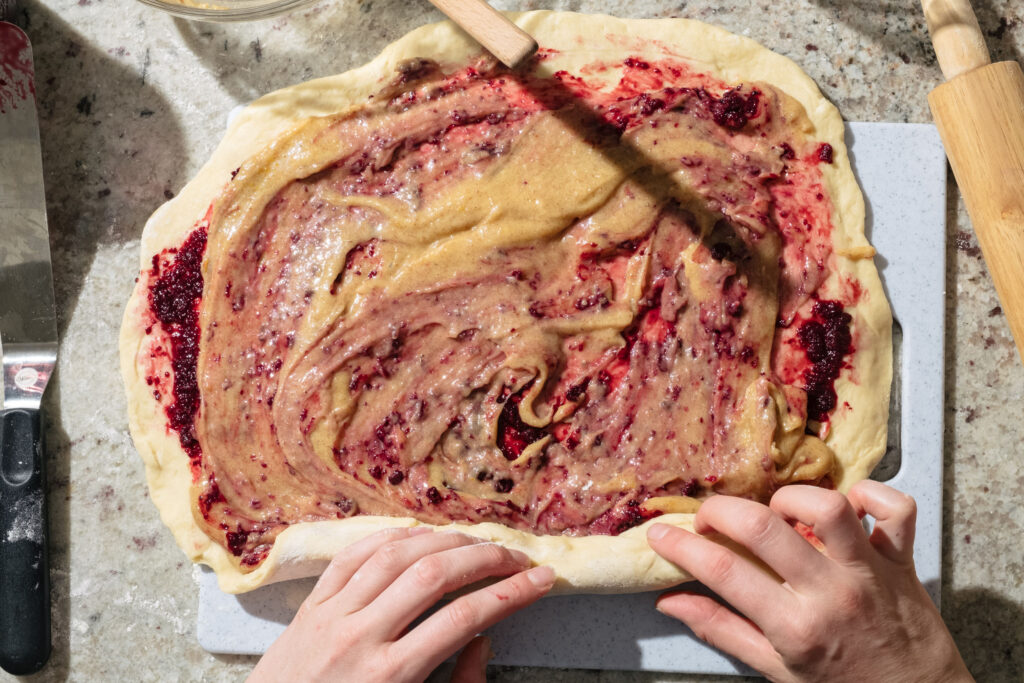
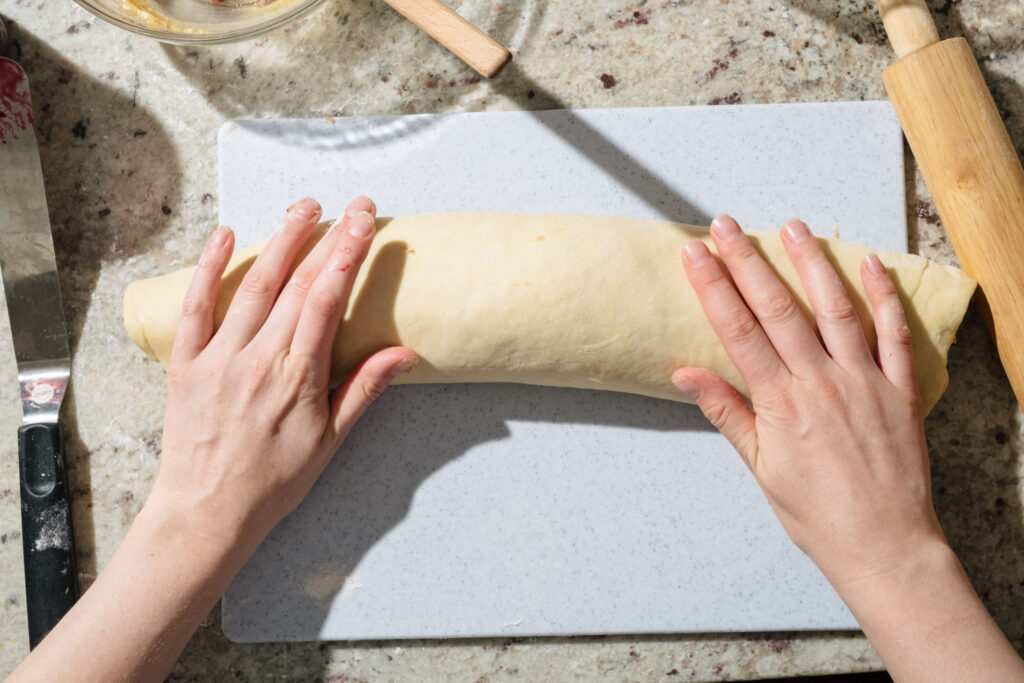
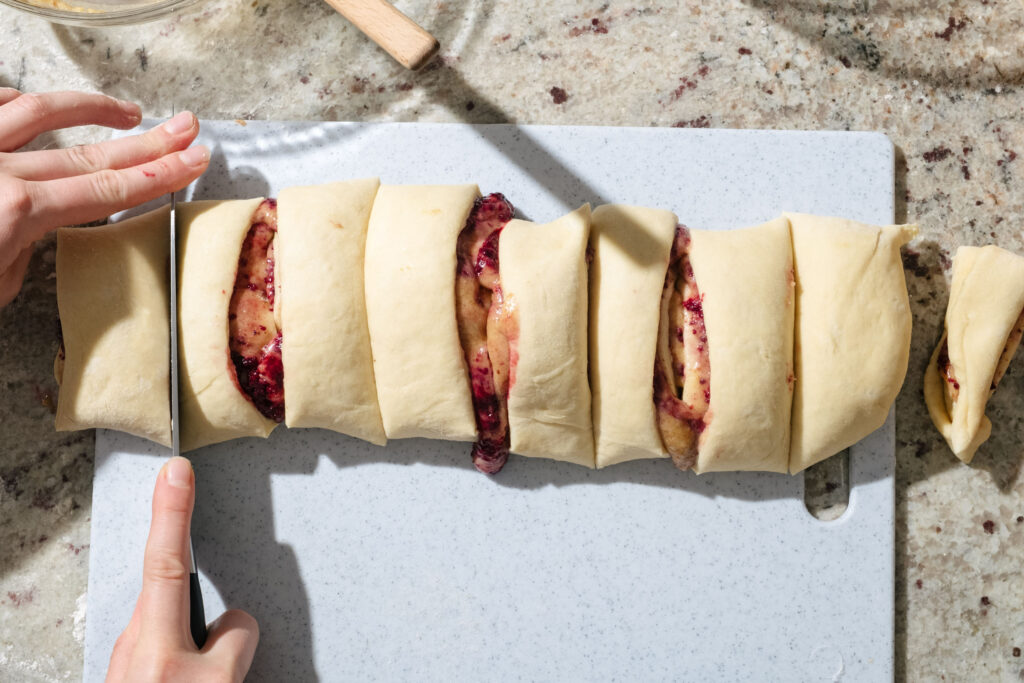
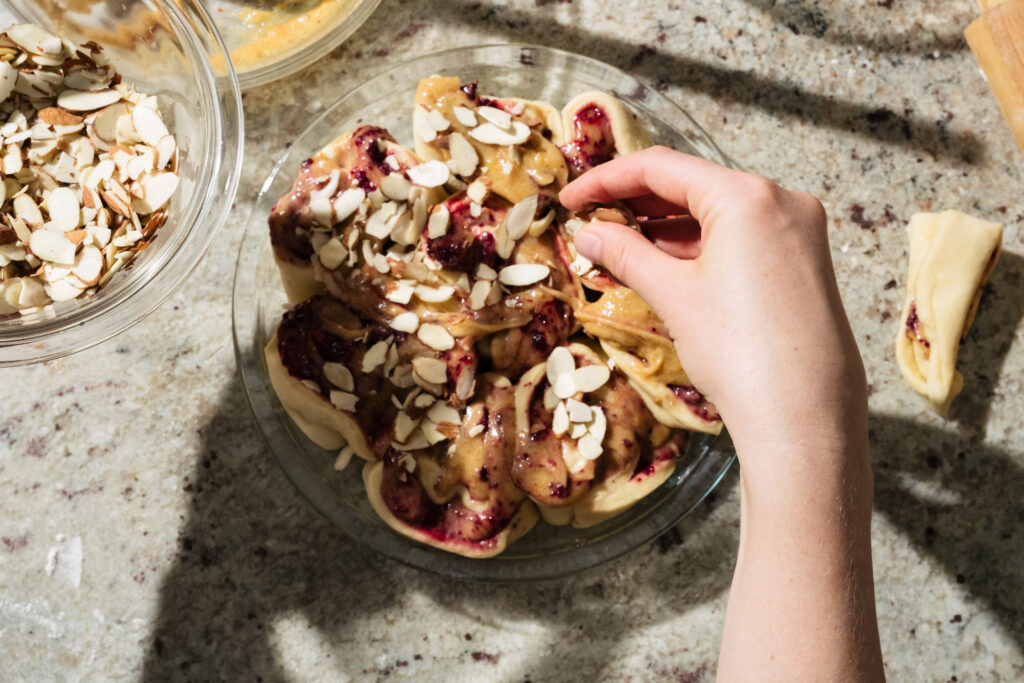
for the dough
- 1 cup whole milk, warmed to ~110 degrees Fahrenheit
- 2 ¼ teaspoons (1 packet) active dry yeast
- 2 tablespoons + 1 teaspoon granulated sugar
- 2 eggs
- 3 ½ cups flour (all-purpose or bread flour)*
- 1 ½ teaspoons salt
- 4 tablespoons butter, softened
- 1 tablespoon grapeseed, sunflower, or other neutral oil
for the filling (frangipane)
- 1 cup almonds (or 1 cup almond meal)
- ½ cup granulated sugar
- 1 tablespoon flour
- 6 tablespoons butter
- 2 eggs
- 1 teaspoon almond extract
- 1 teaspoon orange zest
- ½ cup raspberry, mixed berry, apricot jam or orange marmalade
for the topping
- ¼ cup slivered almonds
- Powdered sugar
*A note about flour: all-purpose or bread flour will both work here but will result in varying textures.
In a saucepan or microwave, heat the milk until it reaches about 110 degrees Fahrenheit. Add the yeast and 2 tablespoons sugar. Mix until the yeast dissolves and let sit for 7 minutes until it starts to bubble.
While the yeast mixture sits, combine the flour, remaining 1 tablespoon sugar, and salt in the bowl of a stand mixer with the paddle. Slowly pour in the yeast mixture and eggs into the flour and mix on low until dough is smooth and shiny, roughly 5 minutes.
Lightly grease a large bowl with a neutral oil like grapeseed or sunflower and place the dough inside. Cover with plastic wrap and let sit 2 hours until it has doubled in size.
Meanwhile, place the almonds and sugar in a food processor and grind until they form a meal. Add the flour and butter and continue to blend until combined. Add in eggs, one at a time and pulse. Add almond extract and orange zest. Set aside.
Once dough has doubled in size, preheat oven to 375°F. Roll out dough onto a floured surface and spread with jam. Spoon frangipane onto dough and spread out.
Starting at the wide side of the dough, roll the dough together, pinching as you go. Pinch the ends and seam. Cut into 8 large buns and place in a rectangular or round baking dish. Sprinkle with slivered almonds.
Bake for 45 minutes until the dough and frangipane are golden brown and the slivered almonds begin to toast. Dust with powdered sugar.
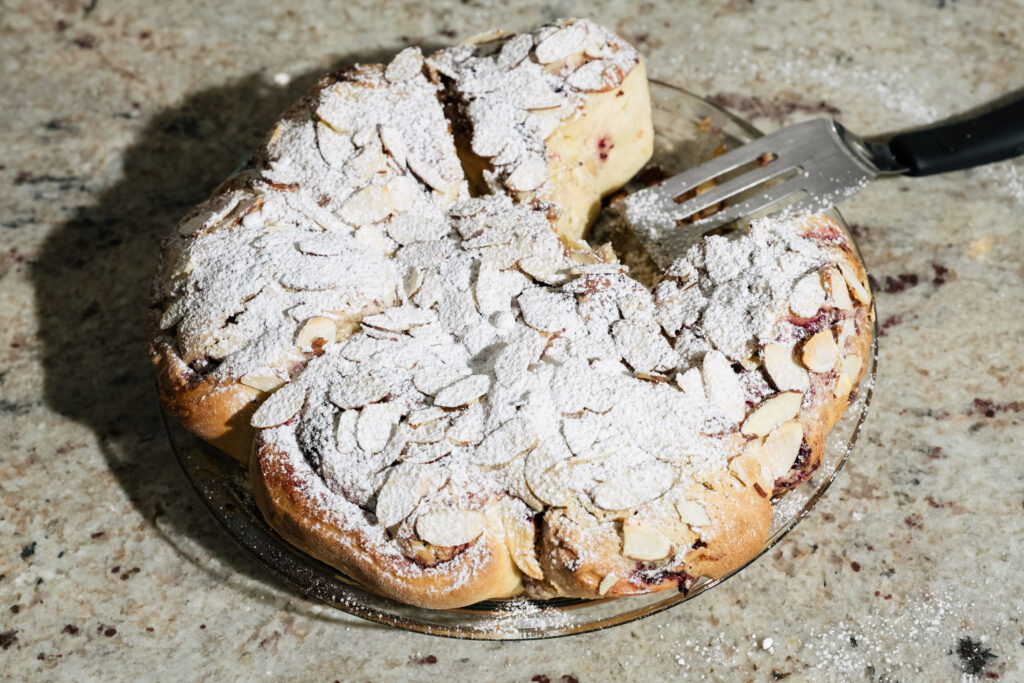
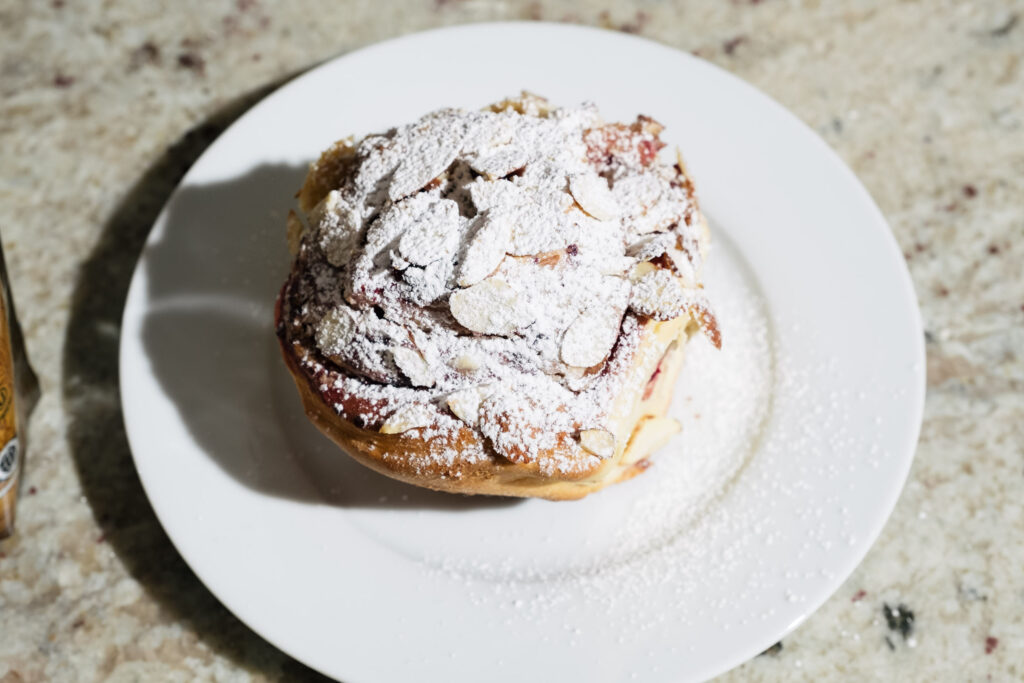
frangipane
Almond croissants are one of my favorite foods in the entire world. They are sweet and delightful and the mere thought of their features ignites my senses with a wistful longing to eat one right now. What makes them so special is that nestled between the airy, buttery, flaky layers that are the croissant, is frangipane.
Frangipane is the rich, almond paste filling layered with flavor, which is part of what makes almond croissants so delightful. Frangipane can also be spread on stale bread to rejuvenate it into bostock or used in cakes and cookies to make them that much more special.
ingredients
- 1 cup almonds (or 1 cup almond meal)
- ½ cup granulated sugar
- 1 tablespoon flour
- 6 tablespoons butter
- 2 eggs
- 1 teaspoon almond extract
- 1 teaspoon orange zest
steps
Place the almonds and sugar in a food processor and grind until they form a meal. Add the flour and butter and continue to blend until combined. Add in the eggs, one at a time, and pulse. Add the almond extract and orange zest. Set aside.
chicken a la king with biscuits
Chicken a la king is a classic old fashioned dish, kind of like a deconstructed chicken pot pie, without the crust and switching up some of the veggies. I remember my mom making it for dinner on cold winter nights, served over rice, and its true soul-warming power.
My version of chicken a la king includes multi-colored peppers and pancetta which add flavor and decadence without weighing down the meal. The flaky biscuits remind me of classic Pillsbury Grands!, but are super easy to make and quite rewarding. Choose chicken a la king on a chilly night when the sun has set at 5pm and all you want is to be comfy and relaxed.
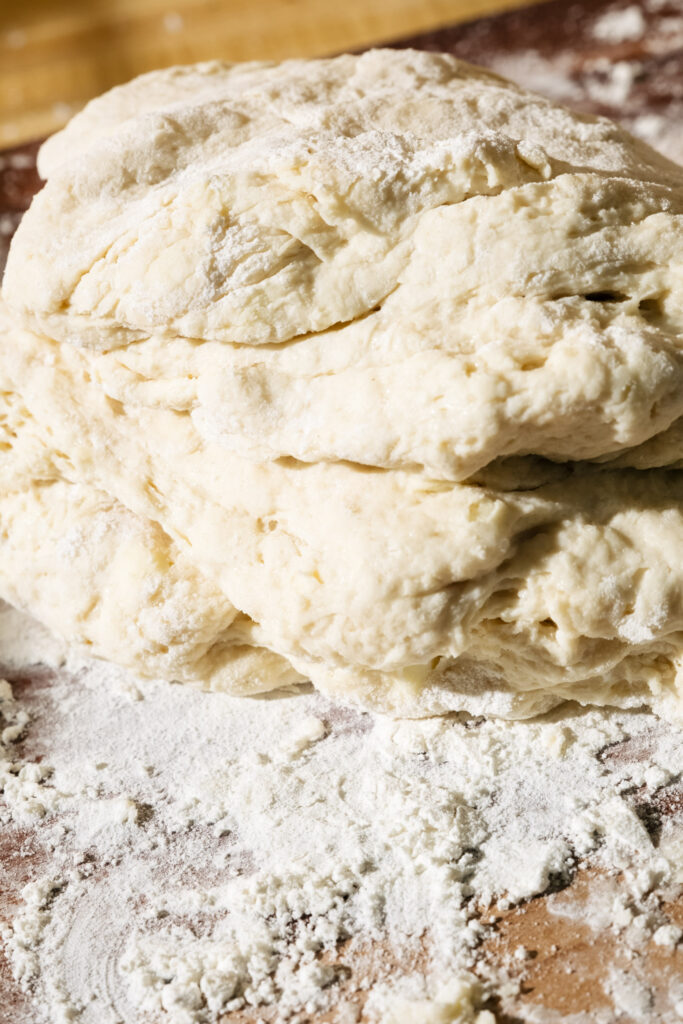
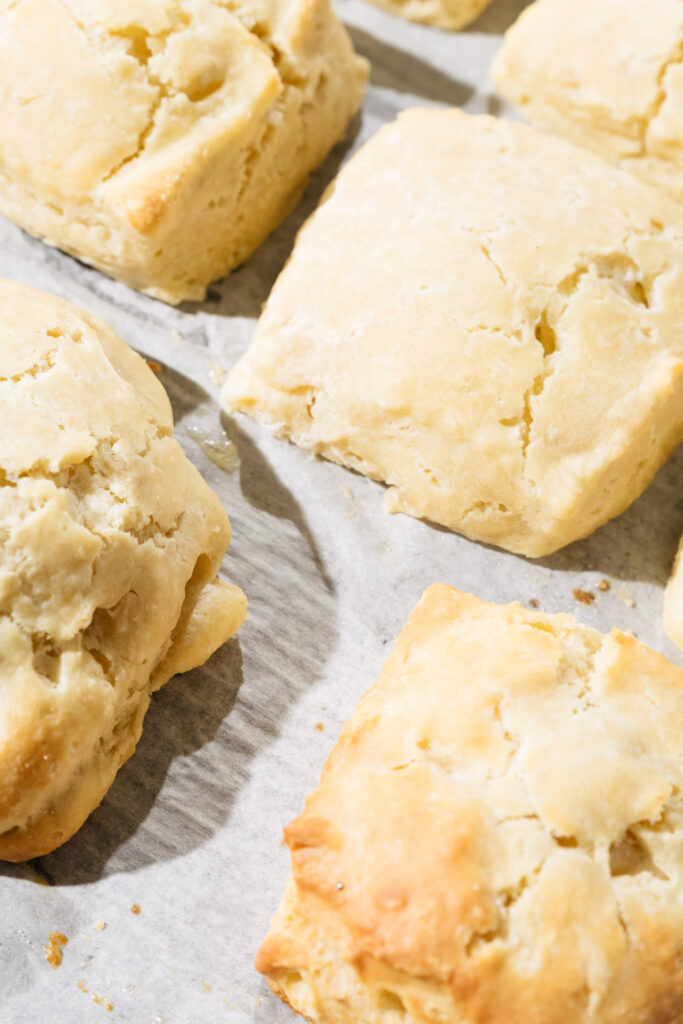
Serves 6
ingredients
for the biscuits
- 1 cup half and half or milk
- 2 tablespoons white vinegar
- 2 cups all-purpose flour
- 2 tablespoons baking powder
- 1 tablespoon sugar
- 1 teaspoon salt
- 5 tablespoons butter, sliced
for the chicken and sauce
- 2 cups boneless skinless chicken breasts, chopped into ½ inch sized-pieces
- 2 tablespoons olive oil, divided
- 1 tablespoon butter
- 1 pound of baby bella cremini mushrooms, sliced
- 1 red bell pepper
- 1 green bell pepper
- 1 orange bell pepper
- 3 teaspoons salt, divided
- 3 teaspoons freshly ground black pepper, divided
- 1 shallot
- 4 ounces pancetta, diced
- ½ cup flour
- 1 ½ cups milk
- 1 ¼ cups chicken stock
biscuit steps
Pour half and half into a measuring cup or glass jar and add vinegar. Let sit. This will curdle it to create buttermilk.
Place the flour, baking powder, sugar, and salt into a food processor and pulse 3 times. Add the sliced butter to the food processor and pulse 6-10 times until the butter is the size of peas. Pour into a bowl and add the buttermilk. Mix until the dough is combined.
Turn the dough out onto a well-floured surface then flatten it, using a rolling pin or your hands, to about 1 inch thick. Fold one side over the other side. Flatten again and fold again. Do this 2 more times then fold again and wrap the folded dough in plastic wrap without flattening. Refrigerate for 30 minutes to 4 hours.
When ready to bake, preheat the oven to 425°F. Roll the dough out on a floured surface and cut into squares using a cutter or a knife. Bake until golden, 20-22 minutes.
chicken and sauce steps
Season the chopped chicken with 1 teaspoon of the salt and 1 teaspoon pepper. Set aside. In a large pan, cook the mushrooms in 1 tablespoon of olive oil and 1 tablespoon of butter until the mushrooms have shrunk in size and browned, about 20 minutes.
Meanwhile, core and cut the peppers in half and place skin-side down on a baking sheet lined with parchment paper. Drizzle with remaining 1 tablespoon of olive oil and season with 1 teaspoon salt and 1 teaspoon pepper. Roast at 425°F (I recommend you do this simultaneously as you bake the biscuits) for about 10 minutes.
When the mushrooms have browned, add 4 ounces of diced pancetta to the pan. Cook together for 5 minutes until the pancetta begins to crisp but is still chewy and not totally crispy.
Remove the peppers from the oven and dice. Add to the mushrooms and pancetta and cook for 5 minutes. Stir in 2 tablespoons flour, remaining 1 teaspoon salt and remaining 1 teaspoon pepper. Cook for 2 minutes until the flour begins to bubble. Add the milk and chicken stock and bring to a boil.
Once the sauce has reached a boil, add the chicken and cook for 5 minutes until sauce thickens. It is during this that the chicken will cook. Turn off the heat, cover and let sit for 5 minutes.
moravian sugar cake
Coffee cake is something my sister and I have loved all our lives. Growing up, we were drawn to all different kinds, but so long as the cake had crumbs or layers of spiced streusel, we were sold.
Nowadays, I seek out delicious coffee cakes with nuts, spices and layers of that distinct sweetness wherever I go. It was while perusing “Mrs. Fryer’s Cook Book and Practical Home Economics,” first published in 1913, when I stumbled on Moravian Cake. Upon further research, I discovered that Moravian sugar cake is a yeasted coffee cake, upgraded by the unlikely addition of mashed potatoes.
Before you scroll away, thinking potatoes do not belong in cake, please give me the opportunity to explain. Mrs. Fryer’s recipe is more of a basic yeasted dough which adds sugar and cinnamon and omits the potato. Below, I have devised a more traditional version of Moravian sugar cake which uses mashed potatoes. The potatoes are evenly incorporated into the dough and create a spongy texture that is lush and chewy, enhanced by brown sugar and cinnamon in every bite.
Moravian sugar cake is a gift from the Moravians, a Slavic group who traveled to America in the 1700s and settled largely in Pennsylvania and North Carolina (hence, Moravian College in Bethlehem, PA). It is typically served at Easter, but why wait until then to enjoy it?
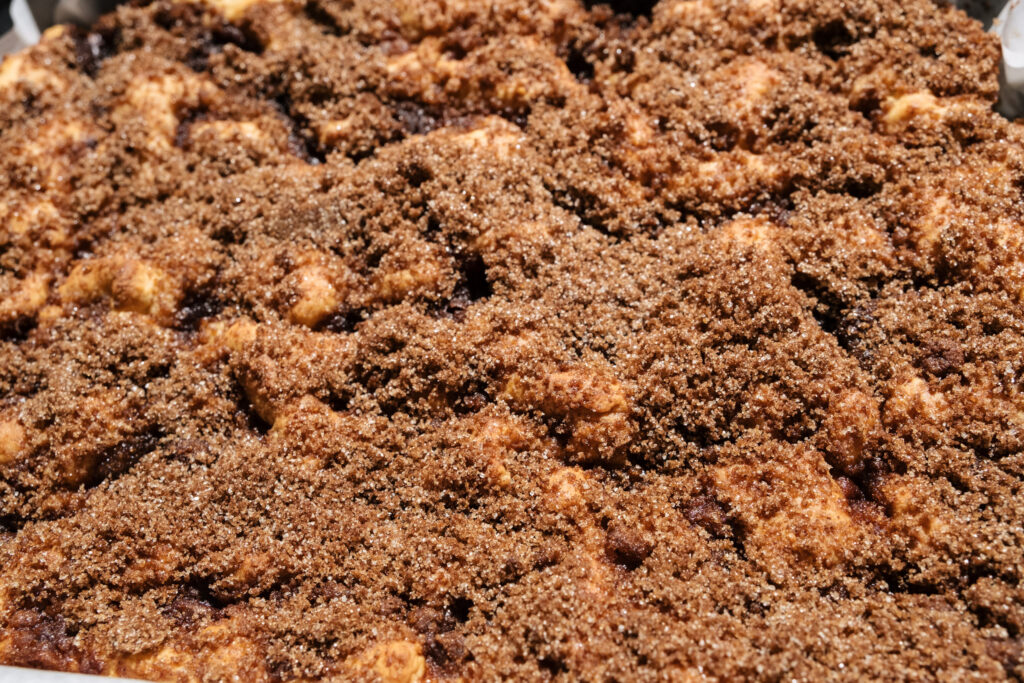
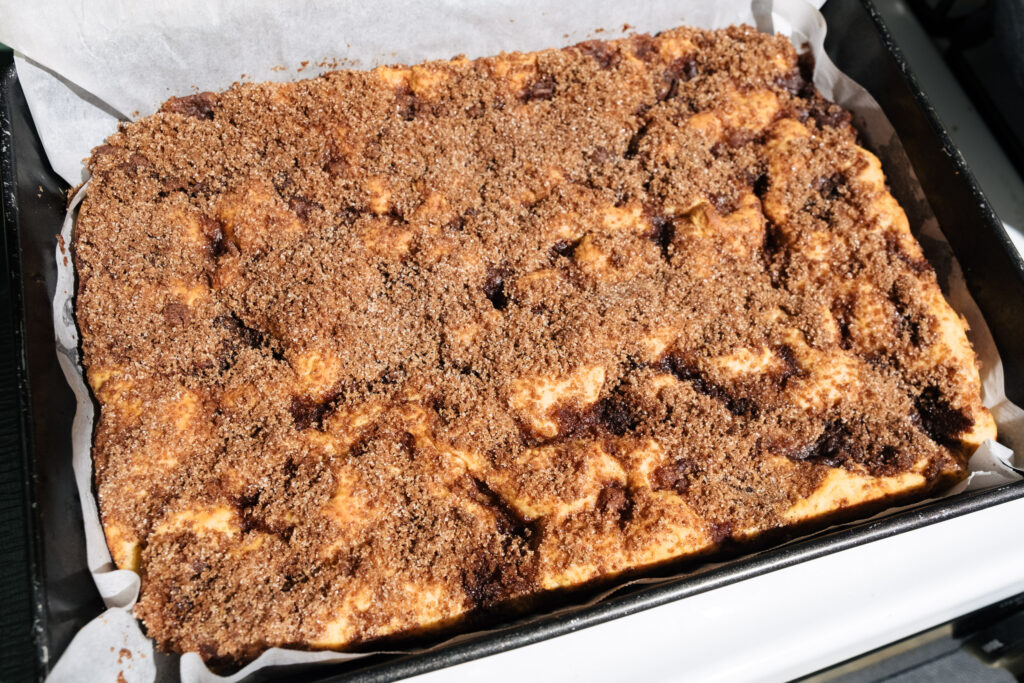
ingredients
- 2 medium russet potatoes
- 7 tablespoons butter, divided
- ½ cup + 2 tablespoons lukewarm water
- 2 ¼ teaspoons active dry yeast
- 1 egg
- ½ cup sugar
- 1 teaspoon kosher salt
- 3 cups flour
- 1 tablespoon neutral oil such as sunflower or grapeseed
- ¾ cup brown sugar
- 1 tablespoon cinnamon
steps
Peel and cut the potatoes into ½ inch pieces. Boil in well salted water for 22 minutes.
While the potatoes boil, melt 6 tablespoons butter in a saucepan and let cool. Pour ½ cup of water into a measuring cup and add 2 ¼ teaspoons yeast to activate it. Mix and let sit until bubbly.
Drain the potatoes and place in a bowl then mash with 1 tablespoon butter. Add remaining 2 tablespoons of water. Add the egg, sugar, yeast mixture, and salt. Mix in flour ½ cup at a time. Knead in the bowl for about 5 minutes. (I used a stand mixer with dough hook attachment for this)
Coat a large clean bowl with neutral oil and place the dough inside. Cover with plastic wrap or a kitchen towel and let rise for 2 hours until it has doubled in size.
In a small bowl, mix together the brown sugar and cinnamon.
Preheat the oven to 425°F. Place the dough into a rectangular pan or baking dish greased and lined with parchment paper. Press and pinch into the dough with your fingers to create the indentation pattern on top. Sprinkle with brown sugar mixture and let sit for 10 minutes.
Bake for 30 minutes until golden on the edges.
